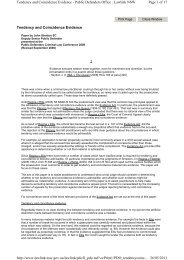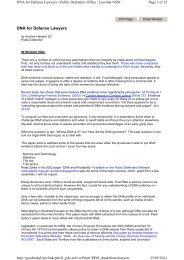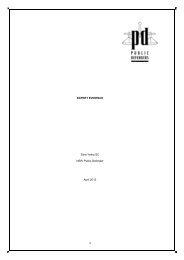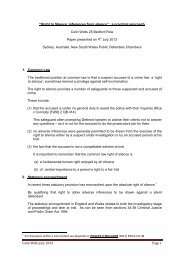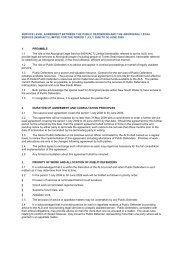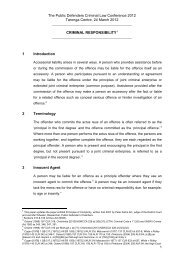DNA for NJC - The Public Defenders
DNA for NJC - The Public Defenders
DNA for NJC - The Public Defenders
You also want an ePaper? Increase the reach of your titles
YUMPU automatically turns print PDFs into web optimized ePapers that Google loves.
Evidence of a match or consistency between the <strong>DNA</strong> 5 profile of a person (most often a suspect)<br />
and a profile derived from a crime scene stain and a statistical estimate as to the rarity of the<br />
profile is now generally accepted in all Australian Courts as evidence admissible to prove a fact in<br />
issue in the proceedings. Such evidence must be presented person with “specialised<br />
knowledge” 6 and supported by evidence as to the source and continuity of the sample analysed. 7<br />
That said <strong>DNA</strong> evidence and the apparent weight given to match results by statistical calculations<br />
still present significant challenges to the criminal justice system. <strong>The</strong>se challenges affect, or in<br />
some cases afflict, how <strong>DNA</strong> evidence is gathered and interpreted and how it is presented and<br />
explained in Court. Given the often uncritical acceptance of <strong>DNA</strong> evidence and the attendant<br />
danger of miscarriages of justice, I want to discuss five areas which illustrate the problems courts<br />
face when presented by <strong>DNA</strong> profile match evidence: 8<br />
1. <strong>The</strong> efficacy of <strong>DNA</strong> typing from very low levels of <strong>DNA</strong>;<br />
2. <strong>The</strong> possibility and impact of contamination;<br />
3. <strong>The</strong> validity of convictions based solely on <strong>DNA</strong> evidence;<br />
4. Judicial incapacity in dealing with statistics; and<br />
5. Possible ways of recognising these problems and simplifying the presentation of <strong>DNA</strong><br />
profile match evidence in criminal courts.<br />
Low Template <strong>DNA</strong> (LT<strong>DNA</strong>) Analysis<br />
<strong>The</strong> remarkable success of <strong>DNA</strong> typing has led to attempts to analyse increasingly smaller<br />
samples containing <strong>DNA</strong>, equivalent to less than twenty cells. This was known as low copy<br />
number (LCN) and more recently low template <strong>DNA</strong> (LT<strong>DNA</strong>) typing and has resulted in a<br />
new category of samples referred to as ‘touch’ or ‘trace’. <strong>The</strong> standard <strong>DNA</strong> methods<br />
currently used require from 200 picograms (200pg) of <strong>DNA</strong> to 2 nanograms (2ng). 9 LT<strong>DNA</strong><br />
typing is normally achieved with a slight modification of the testing procedure. It was first<br />
done at the Forensic Science Services in the UK in 1999 10 and concerns regarding its use<br />
have been expressed in the <strong>for</strong>ensic science literature 11 . Part of the validation of any<br />
5 Deoxyribonucleic acid - <strong>DNA</strong> is found in all cells, except red blood cells.<br />
6 Section 79 Evidence Act 1995.<br />
7 R v Karger (2001) 83 SASR 135.<br />
8 <strong>The</strong>re are many others, including privacy and genetic security issues. See Essentially Yours: <strong>The</strong> Protection of Human<br />
Genetic In<strong>for</strong>mation in Australia, ALRC Report 96, 2003.<br />
9 A nanogram is one thousand millionth of a gram. A picogram is one thousandth of a nanogram.<br />
10 Gill, P. et al. (2000) An investigation of the rigor of interpretation rules <strong>for</strong> STRs derived from less than 100 pg of <strong>DNA</strong>.<br />
Forensic Sci. Int. 112, 17–40.<br />
11 Budowle, B., Eisenberg, A.J. and van Daal, A. (2009) Validity of low copy number typing and applications to <strong>for</strong>ensic<br />
science. Croat. Med. J. 50, 207–17.<br />
2



